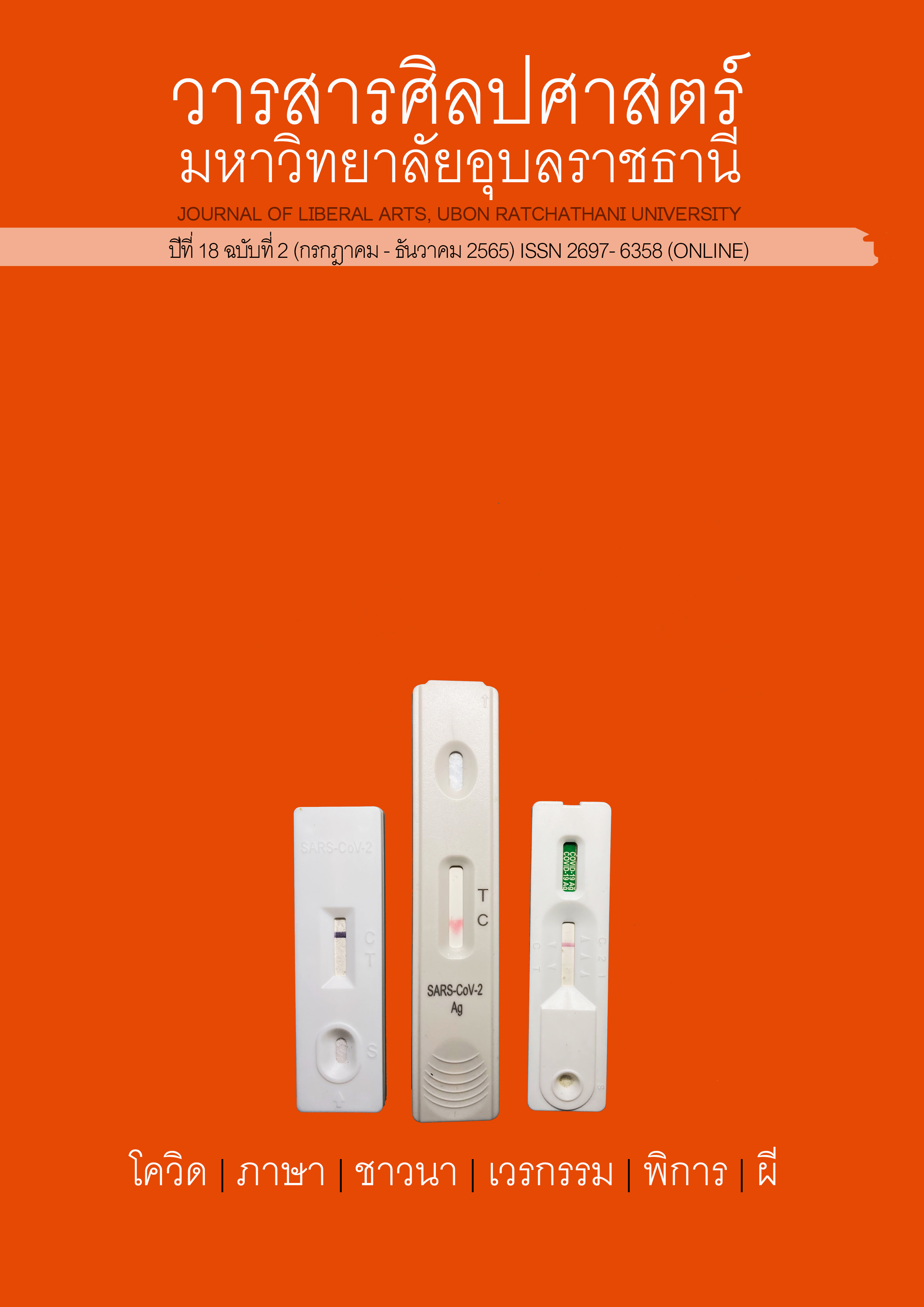การปฏิสัมพันธ์ทางสังคมกึ่งความจริงในการสอนภาษาอังกฤษผ่านสื่อ: กรณีศึกษารายการสอนภาษาอังกฤษในประเทศไทย
Main Article Content
บทคัดย่อ
การวิจัยนี้มีวัตถุประสงค์เพื่อศึกษาการปฏิสัมพันธ์ทางสังคม เทคนิคและวิธีการสอน ตลอดจนรูปแบบของการจัดรายการ ผ่านมุมมองของการวิเคราะห์วาทกรรมสื่อหลากรูปแบบ อันนำไปสู่ความสำเร็จในการสร้างแรงจูงใจในการเรียนภาษาอังกฤษให้แก่ผู้ชมรายการและก่อให้เกิดความนิยมในการติดตามรับชมรายการ โดยใช้วิธีการวิจัยเชิงผสานวิธีแบบคู่ขนาน ดำเนินการวิจัยเชิงปริมาณโดยใช้แบบสอบถามจากกลุ่มตัวอย่างจำนวน 400 คน เพื่อศึกษาการเกิดแรงจูงใจและความนิยมที่ผู้ชมมีต่อพิธีกรและรายการ ควบคู่ไปกับการวิจัยเชิงคุณภาพโดยใช้การวิเคราะห์ตัวบทจากคลิปวิดีโอของรายการ เพื่อศึกษาการนำเสนอของรายการ ผลการศึกษาในเชิงปริมาณพบว่าผู้ชมรายการนิยมรับชมรายการลูกกอล์ฟ อิงลิชรูม รายการอิงลิช อาฟเตอร์นุ่น และรายการมูฟวี่ แลงเกวจ ตามลำดับ และระดับการปฏิสัมพันธ์ทางสังคมกึ่งความจริงที่ผู้ชมมีต่อพิธีกรรายการสอนภาษาอังกฤษทั้งสามอยู่ในระดับมาก ส่วนผลการศึกษาเชิงคุณภาพพบว่ารายการสอนภาษาอังกฤษทั้งสามรายการได้นำวิธีการสอนแบบผสมผสานมาใช้ ทุกรายการนำรูปแบบของการจัดรายการแบบสนทนามาใช้ รวมถึงใช้กลวิธีการสร้างอารมณ์ขัน กลวิธีการสร้างแรงจูงใจ และสื่อหลากรูปแบบอื่น ๆ เพื่อสร้างการปฏิสัมพันธ์ทางสังคมกึ่งความจริงกับผู้ชมรายการ
Downloads
Article Details

This work is licensed under a Creative Commons Attribution-NonCommercial-NoDerivatives 4.0 International License.
References
Bordwell, D. & Thompson, K. (2004). Film Art: an Introduction. Boston: McGraw-Hill.
Bell, N.D. & Pomerantz, A. (2016). Humor in the Classroom: A Guide for Language Teachers and Educational Researchers. New York: Routledge.
Brown, H. D. (2000). Principles of Language Learning and Teaching. (7th ed.). New York: Longman.
Chinnalong, S. (2000). English Teaching of the Television Program Fud Fid For Fi. [in Thai]. M.Com.Arts (Mass Communication), Chulalongkorn University.
Darasawang, P. (2007). “English Language Teaching and Education in Thailand: A Decade of Change.” In Prescott, D., editor. English in Southeast Asia: Varieties, Literacies and Literatures. (p. 187–204). Newcastle upon Tyne: Cambridge Scholars Publishing.
Dörnyei, Z. & Csizér, K. (1998). Ten Commandments for Motivating Language Learners: Results of an Empirical Study. Language Teaching Research, 2 (3), 203–209.
Kaewthep, K. (2010). New Perspectives in Communication Studies. [in Thai]. Bangkok: Pabpim.
Koraneekit, P., Songkram, N. & Khlaisang, J. (2014). Educational Technology and Communications: Innovation in Blended Learning. [in Thai]. Bangkok: Chulalongkorn University Press.
Kress, G. & van Leeuwen, T. (2006). Reading Images: The Grammar of Visual Design. New York: Routledge.
Larsen-Freeman, D. (2000). Techniques and Principal in Language Teaching. (2nd ed.). New York: Oxford University Press.
Mina, P. (2018). The Strategies of Creating Humor in Thai Television Programs. [in Thai]. Veridian E-Journal Silpakorn University, 11 (3), 2300-2313.
O’Halloran, K. L. (2013). “Multimodal Discourse Analysis.” In Hyland, K. & Paltridge, B., editor. The Bloomsbury Companion to Discourse Analysis. (p. 120-137). London: Bloomsbury.
O’Keeffe, A. (2006). Investigating Media Discourse. New York: Routledge.
Phothong, S. & Anchaleewittayakun, W. (2018). Using Storytelling as a Teaching Method to Develop English Speaking Skills of the Sixth Grade Students. [in Thai]. Suandusit Graduate School Academic Journal, 14 (2), 145–154.
Pinzon-Jacome, L. M., Lozano-Jaimes, C. A. & Duenas-Angulo, L. C. (2016). From Feedback to Follow-up In The Third Turn of IRF Sequences: A Challenge to Promote Genuine Interaction in EFL Classes. Rastros Rostros, 18 (33), 72–81.
Promwong, C., Thatang, N. & Janopas, A. (1997). Radio and Television in Education. [in Thai]. Nonthaburi: Sukhothai Thammathirat Open University Press.
Rubin, M., Perse, M. & Powell, A. (1985). Loneliness, Parasocial Interaction, and Local Television News Viewing. Human Communication Research, 12 (2), 155–180.
Sataporn, S. (2011). Linguistics and Language Teaching (Unit 15). [in Thai]. Nonthaburi: Sukhothai Thammathirat Open University Press.
Sikkabundit, S. (2004). Learning Interaction. [in Thai]. Encylopedia of Education Srinakharinwirot University, 31, 51-56.
Sthapitanon, P. (2000). “Edutainment for Social Change.” [in Thai]. In Kaewthep, K., editor. View of New Media and New Society. (p. 274-362). Bangkok: Edison Press Products.
Sutadarat, S. (2021). Theories of English Teaching. (4th ed.). [in Thai]. Bangkok: Ramkhamhaeng University Press.
Yiemkuntitavorn, S. (2017). Learn English From Materials and Activities. [in Thai]. Bangkok: Chulalongkorn University Press.

